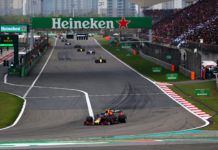Pirelli will test new rear construction in next week’s F1 Austrian GP FP session and if all is well, they could deploy it into full effect from British GP.
Pirelli announced a FP1 test in next weekend’s F1 Austrian GP, where the Italian manufacturer will be running a more robust rear construction, which adds to their latest technical directive on the parameters of running a tyre compound.
The tyres will only have a construction change, with no performance alteration, so that there is no disparity in the middle of the 2021 F1 season. Next week, Pirelli will provide two sets of the new tyres, which teams can use in either of the practice session.
If the test is successful, they will introduce the more robust construction from as early as British GP at Silverstone. Pirelli notes that the new construction incorporates some of the elements they will have in next year’s 18-inch compounds.
The statement goes: “Pirelli, in agreement with the FIA, Formula 1 and the teams, will test a new rear construction of tyre in free practice at the Austrian Grand Prix on Friday 2 July to evaluate its effectiveness to further improve robustness of the tyres.
“This decision has been taken in addition to the recently issued technical directive and the latest starting parameters prescribed by Pirelli, in light of the fact that it is not currently possible to monitor running conditions in real time.
“This will remain the case until next year, when standard Tyre Pressure Monitoring System (TPMS) sensors will be introduced across all teams. Next Friday, each driver will have two sets of these new tyres available for use during either free practice session.
“If the test is successful, the new rear specification will be introduced from the British Grand Prix onwards, replacing the current specification. The new rear construction incorporates some elements that have been developed for use in the latest 18-inch Formula 1 tyres from 2022. With this new structure Pirelli provides a tyre that can guarantee even greater levels of integrity under the extreme conditions that can be generated by the current cars.”
Speaking to media including FormulaRapida.net, Pirelli F1 chief Mario Isola revealed that the construction they will test is the C4 compound and that there will be no performance difference to upset the teams – at least that’s what they can understand from the data they have with the indoor testing.
At the moment, they have planned to test it in Austria to introduce in Britain, but if it rains next weekend, they will have to discuss about it. Isola stated that the production is already in place and they had to put the factory in use for F1 work more to meet the deadlines. Also, for the change on the tyres, they can do it on safety grounds.
Here’s what Isola said on multiple topics:
On why the change and what changes –
Isola: “We believe that the change is going to happen. But obviously we are talking about the construction that we never tested before on track. That construction an idea that we had the last year when we were developing the 13 inches tyre for 2021. If you remember, we tested different constructions in Portimao and then we had a deadline to respect the FIA and the teams, so we went with the current construction.
“But after Portimao or in the period in which we’re in Portimao, we had also some other ideas on how to make the tyre more robust and we made some prototypes. So one of those prototypes was also tested with our indoor test. We usually do several indoor tests to assess the level of integrity of the tyre and the new construction was positive in this regard. So the 2021 construction is for sure a step, but better than 2020. The new one we want to propose that is a, another clear step in, in the direction of having a tyre that is more robust than the current one.
“Why we believe and wanted to test it and why we want to introduce it? It is through the new technical directive, we now have a much better situation. The number controls and the type of controls made by the FIA giving us a good guarantee about the way in which teams are running the tyres that is clear, but it’s also clear that we don’t have a standard sensor. We said that we have to wait until 2022 as it’s impossible to introduce a standard sensor. So, the situation has improved massively compared to few races ago, but we still have this impossibility to check the running pressure.
“So we believe that having this solution in the pocket and not using it is not the right decision. And that’s why we want to test it. Obviously, they give us all the teams the opportunity to test it in Spielberg and to introduce it from Silverstone. I’m not expecting a different drivebility. Obviously it is a different construction, that’s down to geometry and design of the tyre.
“We are not going to change the profile, the external profile, because otherwise there’s affects that design of the floor and the downforce on the, on the rear of the car. So it is not going to change these elements but it is more robust. As I said, in terms of probability, I’m not expecting a big shift in balance or something like that, but we need to test it on track to know that.”
Challenge in production:
Isola: “It was a challenge for our supply chain, as you can understand, because reacting is so short time, it was really difficult. The only, lets say, advantage we had was to have a specification that was already designed because otherwise, where we had to start from zero, that was not possible in these a shorter timeframe. So we have the radius specification available. And as I said, we made a few prototypes for our indoor testing. So we already had the feedback from our indoor testing from a few months ago, and that the challenge was to produce the prototypes for Spielberg.
“And of course also the tyres for Silverstone, we have a bit more time for Silverstone. We had to physically block the factory and stop the production for the new one. We have some tyres that we already produced for the following races. Clearly we try to produce them a bit in advance to talk of tyres available. And there is the possibility that we are not going to use those tyres in the future races, because if we introduced a new one, obviously those tyres are not more, not usable anymore.”
Is this a Baku after effect:
Isola: “No, obviously, what happened in Baku was an evident that we had some parameters that we are not completely under control. That is why we have the TD. And, as I said, that the other action was to consider the possibility to introduce a different construction and more robust construction. Obviously, when we were talking about that, it was just an idea. Then we have to look back to what we did the end of last year in terms of development. And there was the idea to try this new construction, because as I said, indoor testing is a step or improvement. So it is giving us more margin basically.”
New construction can be used in lower pressure, if successful:
Isola: “The new construction is designed to work at a lower pressure compared to the current one, because as I said, the being more robust, you can run it at a lower pressure. And then the pressure obviously is always defined on the simulation, what you see and also considerations, which is the level of running pressure. So, yeah, if we have a direct comparison between the current one, for example, just, just to reply in a clear way to your question next week, we are making calculation now, but I’m expecting that we are going to test the new construction at a lower pressure compared to the current one.”
Here’s the whole discussion on Baku issues



















